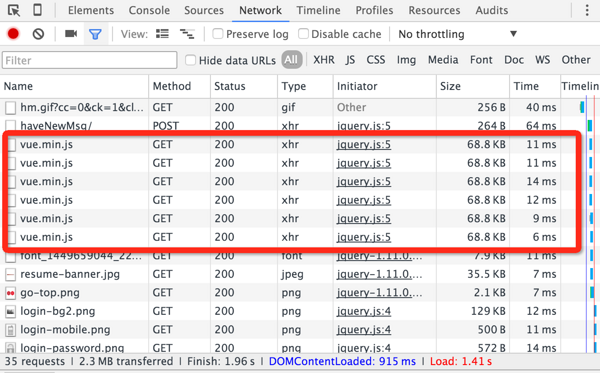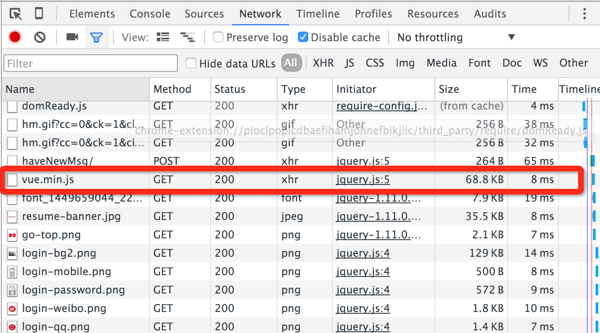Detailed explanation of js asynchronous file loader
We often encounter this scenario. Some pages rely on third-party plug-ins, and these plug-ins are relatively large and are not suitable for packaging into the main js of the page (assuming we are using the cmd method, the js will be packaged into a file), then at this time we usually obtain these plug-in files asynchronously and complete the initialization logic after the download is completed.
Take image upload as an example, we may use the plupload.js plug-in, then we will write like this:
!window.plupload ?
$.getScript( "/assets/plupload/plupload.full.min.js", function() {
self._initUploader();
}) :
self._initUploader();But our pages usually consist of multiple independent modules (components) Composition, if both modules A and B on the page depend on plupload.js, do you need to write the above code in both places? If you do this, two requests may be initiated before plupload.js is downloaded. Since it is downloaded in parallel, the js file may be downloaded repeatedly instead of downloading it for the first time and fetching the cached content the second time.
The following picture shows the situation where multiple components of the page depend on vue.js (scenario where jquery and vue are mixed):

So, in actual use, it is necessary Locking means that when the script is loading, the script should not be requested repeatedly. After the loading is completed, the following logic will be executed in sequence. With the good tool of promise, it is very simple to implement.
// vue加载器
var promiseStack = [];
function loadvue() {
var promise = $.Deferred();
if (loadvue.lock) {
promiseStack.push(promise);
} else {
loadvue.lock = true;
window.Vue ?
promise.resolve() : // 这里写错了,window.Vue为true的时候lock要置为false,我在后面改过来了
$.getScript( "/assets/vue/vue.min.js", function() {
loadvue.lock = false;
promise.resolve();
promiseStack.forEach(function(prom) {
prom.resolve();
});
});
}
return promise;
}
window.loadvue = loadvue;Then depend on vue.js:
loadvue().then(function() { // do something });Look at the request again:

Okay, the problem seems to be solved here , but if there are multiple plug-in dependencies on my page, such as relying on both plupload.js and vue.js, do I have to write the above code again (why do I feel like I have said this)? Wouldn't this be redundant? So we need an asynchronous loader generator that can help us generate multiple asynchronous loaders.
/**
* @des: js异步加载器生产器
* @param {string} name 加载器名称
* @param {string} global 全局变量
* @param {string} url 加载地址
**/
var promiseStack = {};
exports.generate = function(name, global, url) {
var foo = function() {
if (!promiseStack[name]) {
promiseStack[name] = [];
}
var promise = $.Deferred();
if (foo.lock) {
promiseStack[name].push(promise);
} else {
foo.lock = true;
if (window[global]) {
foo.lock = false;
promise.resolve();
} else {
$.getScript(url, function() {
foo.lock = false;
promise.resolve();
promiseStack[name].forEach(function(prom) {
prom.resolve();
});
});
}
}
return promise;
};
return foo;
};Then we can generate an asynchronous loader and assign it to window
// 全局加载器 window.loadvue = loader.generate( 'vue', 'Vue', '/assets/vue/vue.min.js'); window.loadPlupload = loader.generate( 'plupload', 'plupload', '/assets/plupload/plupload.full.min.js');
The same as above when used, which basically solves our problem.
The above are the details about the js asynchronous file loader. I hope it will be helpful to everyone's learning.
For more detailed articles related to js asynchronous file loader, please pay attention to the PHP Chinese website!

Hot AI Tools

Undresser.AI Undress
AI-powered app for creating realistic nude photos

AI Clothes Remover
Online AI tool for removing clothes from photos.

Undress AI Tool
Undress images for free

Clothoff.io
AI clothes remover

Video Face Swap
Swap faces in any video effortlessly with our completely free AI face swap tool!

Hot Article

Hot Tools

Notepad++7.3.1
Easy-to-use and free code editor

SublimeText3 Chinese version
Chinese version, very easy to use

Zend Studio 13.0.1
Powerful PHP integrated development environment

Dreamweaver CS6
Visual web development tools

SublimeText3 Mac version
God-level code editing software (SublimeText3)

Hot Topics
 1668
1668
 14
14
 1427
1427
 52
52
 1329
1329
 25
25
 1273
1273
 29
29
 1256
1256
 24
24
 JavaScript Engines: Comparing Implementations
Apr 13, 2025 am 12:05 AM
JavaScript Engines: Comparing Implementations
Apr 13, 2025 am 12:05 AM
Different JavaScript engines have different effects when parsing and executing JavaScript code, because the implementation principles and optimization strategies of each engine differ. 1. Lexical analysis: convert source code into lexical unit. 2. Grammar analysis: Generate an abstract syntax tree. 3. Optimization and compilation: Generate machine code through the JIT compiler. 4. Execute: Run the machine code. V8 engine optimizes through instant compilation and hidden class, SpiderMonkey uses a type inference system, resulting in different performance performance on the same code.
 Python vs. JavaScript: The Learning Curve and Ease of Use
Apr 16, 2025 am 12:12 AM
Python vs. JavaScript: The Learning Curve and Ease of Use
Apr 16, 2025 am 12:12 AM
Python is more suitable for beginners, with a smooth learning curve and concise syntax; JavaScript is suitable for front-end development, with a steep learning curve and flexible syntax. 1. Python syntax is intuitive and suitable for data science and back-end development. 2. JavaScript is flexible and widely used in front-end and server-side programming.
 From C/C to JavaScript: How It All Works
Apr 14, 2025 am 12:05 AM
From C/C to JavaScript: How It All Works
Apr 14, 2025 am 12:05 AM
The shift from C/C to JavaScript requires adapting to dynamic typing, garbage collection and asynchronous programming. 1) C/C is a statically typed language that requires manual memory management, while JavaScript is dynamically typed and garbage collection is automatically processed. 2) C/C needs to be compiled into machine code, while JavaScript is an interpreted language. 3) JavaScript introduces concepts such as closures, prototype chains and Promise, which enhances flexibility and asynchronous programming capabilities.
 JavaScript and the Web: Core Functionality and Use Cases
Apr 18, 2025 am 12:19 AM
JavaScript and the Web: Core Functionality and Use Cases
Apr 18, 2025 am 12:19 AM
The main uses of JavaScript in web development include client interaction, form verification and asynchronous communication. 1) Dynamic content update and user interaction through DOM operations; 2) Client verification is carried out before the user submits data to improve the user experience; 3) Refreshless communication with the server is achieved through AJAX technology.
 JavaScript in Action: Real-World Examples and Projects
Apr 19, 2025 am 12:13 AM
JavaScript in Action: Real-World Examples and Projects
Apr 19, 2025 am 12:13 AM
JavaScript's application in the real world includes front-end and back-end development. 1) Display front-end applications by building a TODO list application, involving DOM operations and event processing. 2) Build RESTfulAPI through Node.js and Express to demonstrate back-end applications.
 Understanding the JavaScript Engine: Implementation Details
Apr 17, 2025 am 12:05 AM
Understanding the JavaScript Engine: Implementation Details
Apr 17, 2025 am 12:05 AM
Understanding how JavaScript engine works internally is important to developers because it helps write more efficient code and understand performance bottlenecks and optimization strategies. 1) The engine's workflow includes three stages: parsing, compiling and execution; 2) During the execution process, the engine will perform dynamic optimization, such as inline cache and hidden classes; 3) Best practices include avoiding global variables, optimizing loops, using const and lets, and avoiding excessive use of closures.
 Python vs. JavaScript: Community, Libraries, and Resources
Apr 15, 2025 am 12:16 AM
Python vs. JavaScript: Community, Libraries, and Resources
Apr 15, 2025 am 12:16 AM
Python and JavaScript have their own advantages and disadvantages in terms of community, libraries and resources. 1) The Python community is friendly and suitable for beginners, but the front-end development resources are not as rich as JavaScript. 2) Python is powerful in data science and machine learning libraries, while JavaScript is better in front-end development libraries and frameworks. 3) Both have rich learning resources, but Python is suitable for starting with official documents, while JavaScript is better with MDNWebDocs. The choice should be based on project needs and personal interests.
 Python vs. JavaScript: Development Environments and Tools
Apr 26, 2025 am 12:09 AM
Python vs. JavaScript: Development Environments and Tools
Apr 26, 2025 am 12:09 AM
Both Python and JavaScript's choices in development environments are important. 1) Python's development environment includes PyCharm, JupyterNotebook and Anaconda, which are suitable for data science and rapid prototyping. 2) The development environment of JavaScript includes Node.js, VSCode and Webpack, which are suitable for front-end and back-end development. Choosing the right tools according to project needs can improve development efficiency and project success rate.




